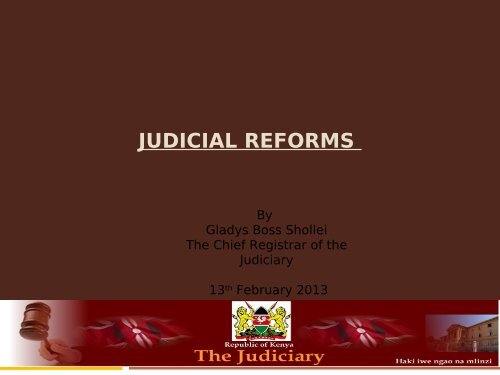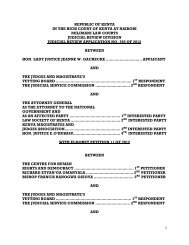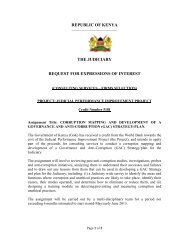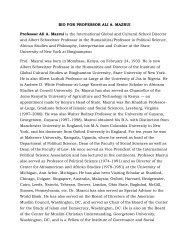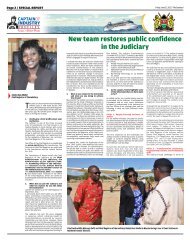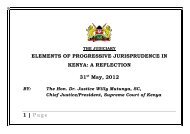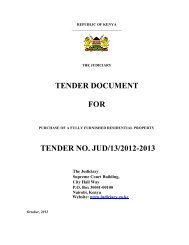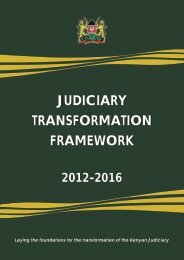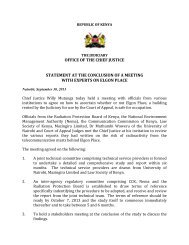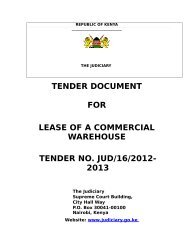download pdf - The Judiciary
download pdf - The Judiciary
download pdf - The Judiciary
Create successful ePaper yourself
Turn your PDF publications into a flip-book with our unique Google optimized e-Paper software.
JUDICIAL REFORMSByGladys Boss Shollei<strong>The</strong> Chief Registrar of the<strong>Judiciary</strong>13 th February 2013
Introduction <strong>The</strong> <strong>Judiciary</strong>’s core mandate is toensure access to justice for all,irrespective of status. For many ordinary people, the quest forjustice has been hampered by lack ofphysical access to courts because oflong distances, complex and unfriendlyprocedures, lack of information on courtprocesses and procedures, delays indetermining cases, and alienation fromthe justice system.
Transformation notReforms However, though the title of thispresentation refers to judicial reformswhat is currently being undertaken atthe <strong>Judiciary</strong> is a transformation. Reforms refer to make better, improvewhat is defective. On the other hand, transformation refersto change in structure, appearance orcharacter, that is a paradigm shift.
Transformation notReforms Cont’d <strong>The</strong> <strong>Judiciary</strong> has over the yearsengaged in various reform initiatives tomake the <strong>Judiciary</strong> efficient and effectivein service delivery. <strong>The</strong>se reform initiatives have beenbased arising from reports’recommendations produced by themany committees and task forces thathad been established.
Transformation notReforms Cont’d However, these initiatives fell short ofthe expected results due to a number ofreasons including: the fact that they were stand aloneprojects; they did not leverage on line managementexpertise, each of them operated like from scratchand did not build on previous work as aresult of which, the initiatives had minimumimpact; and or interfered with efficient case flow
Transformation notReforms Cont’d This scenario, led to loss of public trustand confidence in the <strong>Judiciary</strong>. In addition, the reform process divertedthe <strong>Judiciary</strong> from its core business asmany court officers engaged in supportfunctions. This were more activity based thanresults focused to the detriment of the<strong>Judiciary</strong>’s capacity to implement its coremandate, which is key to the expeditiousdelivery of justice to litigants.
Expectations <strong>The</strong> Constitution of Kenya 2010, the highpublic expectations and demand, thetrust placed in the new leadership forimproved <strong>Judiciary</strong> performance in theadministration of justice and growth ofjurisprudence provide the impetus for apaced people-focused and results-basedholistic strategic framework.
<strong>Judiciary</strong> TransformationFramework As a response to the foregoing, the<strong>Judiciary</strong> developed a <strong>Judiciary</strong>Transformation Framework, Its the overall objective is aligning allreforms to the implementation of theprovisions of the Constitution of Kenya 2010,the National Vision 2030 and its flagshipprojects; the transformation of servicedelivery to make justice accessible,equitable, human rights based as well asvalue driven.
<strong>Judiciary</strong> TransformationFramework Cont’d In meeting this objective, the <strong>Judiciary</strong>has adopted a building block andholistic, integrated and comprehensiveapproach, This is results-based, citizen-centered,built on strategic and technicalpartnerships and benchmarked onemerging national, regional and globalsmart practice ensure that the <strong>Judiciary</strong>is an institution that is fit for purpose. This Framework was launched on the
Progress so far Our work in the past year has restedprimarily on the need to regain publicconfidence through: better services and continuousaccountability; providing access to justice by increasingthe number of judges and magistrates topreside over cases, expansion of court infrastructurethroughout the country, particularly inmarginalized areas, reduction of case backlog,
Progress so farexpansion of training,mobilization of resources to finance ouroperations, and a re-affirmation of ourindependence.Achievements:finalized 421, 827 cases,hired 251 senior staff,established four (4) new High Courts,launched two new magistrates courts,launched a mobile courts initiative for themarginalized areas,
Progress so fardeveloped simplified rules,concluded stalled construction of courtbuildings,conducted Judicial Marches,operationalized the <strong>Judiciary</strong> Fundestablished a public complaints system(<strong>The</strong> Office of the <strong>Judiciary</strong> Ombudsperson)establishment of a mobile phone trafficcourt fines payment system, Faini ChapChap -- at the Kibera and Milimani lawcourts
<strong>The</strong> Office of the <strong>Judiciary</strong>Ombudsperson Established in August 2011 to receiveand respond to complaints from staff, aswell as from the public. <strong>The</strong> Office has received 9, 773complaints from the public. Of these,5,256 files, representing 54 per cent,have been successfully closed. <strong>The</strong>re arestill 2,227 files still open that are beingprocessed.
State of the <strong>Judiciary</strong> <strong>The</strong> Hon. Chief Justice, Dr. Willy Mutungadelivered the first Annual State of<strong>Judiciary</strong> Address on 19 th October 2012. This was a revolutionary milestone inportraying the directness of the new<strong>Judiciary</strong>, the accountability of the neworder and the respect for the people ofKenya, from whom the <strong>Judiciary</strong> derivesits authority. In the address, the ChiefJustice gave stock of our achievementsin the past year and discussed the
State of the <strong>Judiciary</strong> <strong>The</strong> effect of this translates to not onlygaining public confidence locally, but torecognition of the positive reforms the<strong>Judiciary</strong> has embarked oninternationally. <strong>The</strong> <strong>Judiciary</strong> recognizes its role inhelping Kenya realize her Vision 2030and in a system where dispute resolutionis now predictable, investors areconfident to capitalize in Kenya knowingthat they can always depend on our
Conclusion In conclusion, I want to remind you thatArticle 159 of the Constitution of Kenyarecognizes that judicial power is derivedfrom the people. It is from the people that the power istransferred to the courts and relevanttribunals. All citizens must be reminded that this istheir <strong>Judiciary</strong> and thus it must work forthem. <strong>The</strong> <strong>Judiciary</strong> Transformation Framework
ASANTE


